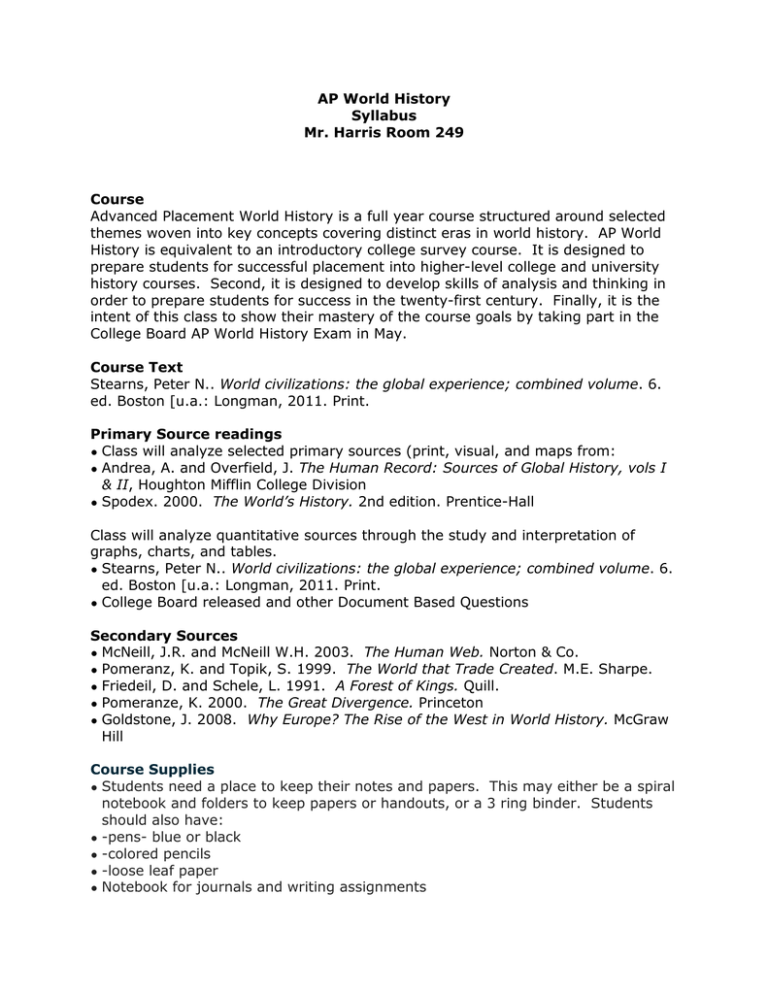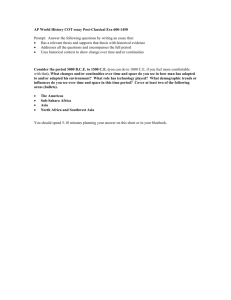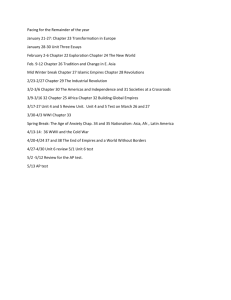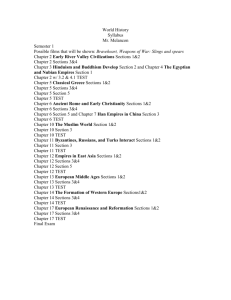AP World History Syllabus Mr. Harris Room 249 Course Advanced
advertisement

AP World History Syllabus Mr. Harris Room 249 Course Advanced Placement World History is a full year course structured around selected themes woven into key concepts covering distinct eras in world history. AP World History is equivalent to an introductory college survey course. It is designed to prepare students for successful placement into higher-level college and university history courses. Second, it is designed to develop skills of analysis and thinking in order to prepare students for success in the twenty-first century. Finally, it is the intent of this class to show their mastery of the course goals by taking part in the College Board AP World History Exam in May. Course Text Stearns, Peter N.. World civilizations: the global experience; combined volume. 6. ed. Boston [u.a.: Longman, 2011. Print. Primary Source readings • Class will analyze selected primary sources (print, visual, and maps from: • Andrea, A. and Overfield, J. The Human Record: Sources of Global History, vols I & II, Houghton Mifflin College Division • Spodex. 2000. The World’s History. 2nd edition. Prentice-Hall Class will analyze quantitative sources through the study and interpretation of graphs, charts, and tables. • Stearns, Peter N.. World civilizations: the global experience; combined volume. 6. ed. Boston [u.a.: Longman, 2011. Print. • College Board released and other Document Based Questions Secondary Sources • McNeill, J.R. and McNeill W.H. 2003. The Human Web. Norton & Co. • Pomeranz, K. and Topik, S. 1999. The World that Trade Created. M.E. Sharpe. • Friedeil, D. and Schele, L. 1991. A Forest of Kings. Quill. • Pomeranze, K. 2000. The Great Divergence. Princeton • Goldstone, J. 2008. Why Europe? The Rise of the West in World History. McGraw Hill Course Supplies • Students need a place to keep their notes and papers. This may either be a spiral notebook and folders to keep papers or handouts, or a 3 ring binder. Students should also have: • -pens- blue or black • -colored pencils • -loose leaf paper • Notebook for journals and writing assignments Class Expectations • The expectations for this class will be created around mutual respect. Come ready to work, have a “can-do” attitude, participate in class, and honor the Social Contract that we will create. T Communication -The best way to reach me is through email at rharris@skyviewacademy.k12.co.us. This is checked regularly and I am able to respond quicker than other forms of communication. I also can meet before school from 7:00-7:30 by appointment as necessary. -Email updates will be sent weekly and grades updated in Infinite Campus by 6:00 pm on Wed. Grading Scale A = 100-90% B = 89-80% C = 79-70% D = 69-60% F = 59% or below Grades are based on a total point scale. Students will take tests roughly every 4 weeks, have weekly in-class writing opportunities, and various homework assignments. These will constitute the largest part of the semester grade. Late policy Late assignments will be deducted 10% per day, or one letter grade, up to 50%. After 5 missing days, the student earns a zero for the grade. Themes in AP World History This course will teach students to view history by examining themes. It is organized around five overarching themes that serve as unifying threads throughout the course. These help students to relate what is particular about each time period or society to a bigger picture of history. The themes also provide a way to organize comparisons and analyze change and continuity over time. Social- Development and transformation of social structures • Gender roles and relations • Family and kinship • Racial and ethnic constructions • Social and economic classes Political- State-building, expansion, and conflict • Political structures and forms of governance • Empires • Nations and nationalism • Revolts and revolutions • Regional, trans-regional, and global structures and organizations Interaction between humans and the environment • Demography and disease. • Migration • Patterns of settlement • Technology Cultural- Development and interaction of cultures • Religions • Belief systems, philosophies, and ideologies • Science and technology • The arts and architecture Economic- Creation, expansion, and interaction of economic systems • Agricultural and pastoral production • Trade and commerce • Labor systems • Industrialization • Capitalism and socialism Schedule Unit I- Technological and Environmental Transformations Key Concepts • Big Geography and the Peopling of the Earth • Neolithic Revolution and Early Agricultural Societies • Development and Interactions of Early Agricultural, Pastoral, and Urban Societies Topics for Overview Include: • Prehistoric Societies • From Foraging to Agricultural and Pastoral Societies • Early Civilzations: Middle East, South Asia, East Asia, the Americas, Africa, and Oceania Special Focus • Concept of Civilization • Activities and Skill Development • Identify and analyze the causes and consequences of the Neolithic Revolution in the major river valleys as well as in Sub-Saharan Africa and Papua New Guinea • Analyze how geography affected the development of political, social, economic, and belief systems in the earliest civilization in Mesopotamia, Egypt, South Asia, East Asia, Mesoamerica, Andes Discussion How were gender roles changed by the Neolithic Revolution? Additional Reading- Chapters 1 and 2 of The Human Web Class will evaluate perspectives on the existence of a very loose knit global web during this period. Unit II- 600 BCE-600 CE: Organization and Reorganization of Human Societies- Classical • Key Concepts • Development and Codification of Religious and Cultural Traditions • Development of States and Empires • Emergence of Trans-regional Networks of Communication and Exchange Topics for Overview include: • Classical Civilzations • Major Belief Systems: Religion and Philosophy • Early Trading Networks Special Focus • World Religions • Animism focusing on Australasia and Sub-Saharan Africa • Judaism and Christianity • Hinduism and Buddhism • Daoism and Confucianism • Developments in Mesoamerica and Andean South America: Moche and Maya • Bantu Migration and its Impact in Sub-Saharan Africa • Trans-regional Trade: The Silk Road and the Indian Ocean • Developments in China: development of imperial structure and Confucian society. Activities and Skill Development • Comparison Essay- Methods of political control in the Classical period. Choose two between Han China, Mauryan/Gupta India, Imperial rome, Persian Empire • Change and Continuity over Time Essay (CCOT): Political and Cultural Changes in the Late Classical Period. Choose from China, India, or Rome. • Evaluate the causes and consequences of the decline of the Han, Roman, and Gupta Empires. • Map the changes and continuities in long-distance trade networks in the Eastern Hemisphere: Eurasian Silk Roads, Trans-Saharan caravan routes, Indian Ocean sea lanes, and Mediterranean sea lanes. • Group Presentations • Each group will research and present a major world religion/belief system. • They will examine origin, beliefs and practices, and diffusion • Read excerpts from A Forest of Kings and watch “Cracking the Maya Code” (PBS Nova). Assess the impact that archaeology and iconography have had on the study of history. Additional Reading- Ch. 3 The Human Web. Students will • Trace the development of civilization in each region and create visual chart • Evaluate the periodization of this era. The use of 600 CE versus 200 CE as the break for the era. Unit III- 600-1450: Regional and Trans-regional Interactions- Post Classical Key Concepts • Expansion and Intensification of Communication and Exchange Networks • Continuity and Innovation of State Forms and Their Interactions • Increased Economic Productive Capacity and Its Consequences Topics for Overview • Byzantine Empire, Dar-al Islam, and Germanic Europe • Crusades • Sui, Tang, Song, and Ming empires • Delhi Sultanate • The Americas • Turkish Empires • italian city-states • Kingdoms and Empires in Africa • The Mongol Khanates • Trading Networks in the Post-Classical World Special Focus • Islam and the establishment of moire • Polynesian Migrations • Empires in the Americas: Aztecs and inca • Expansion of trade in the Indian Ocean: the Swahili Coast of East Africa Activities and Skill Development • Comparative Essay: Comparing the level of technological achievement including production of goods: 500-1000- Middle East, South Asia, East Asia, Eastern Europe • Evaluate the causes and consequences of the spread of Islamic empires. • Compare the Polynesian and viking migrations. • Comparison Essay: Analyze the effects of Mongol conquest and rule within Russia, China, or the Middle East; choose two. • Class debates • Were the economic causes of the voyages of the Ming navy in the first half of the 15th century the main reason for their limited use? • Were the tributary and labor obligations in the Aztec and Inca empires more effective than similar obligations in the Eastern hemisphere? CCOT Essay- Changes and Continuities in patterns of interactions along the Silk • Roads 200 BCE- 1450 CE. Addition Reading • Chapters 4 & 5 of The Human Web. • Trace the development of civilization in each region and create organization chart connecting to the big picture • Evaluate the periodization in the book compared to that of the periodization in the course curriculum. Why 600-1450 vs. the book’s organization of 200-1000 Ce and 1000-1500 CE? • in what regions does each work best? Why? • In what areas does each present a problem? Why? Unit IV: 1450-1750: Global Interactions: Early Modern Key Concepts • Globalizing Networks of Communication and Exchange • New Forms of Social Organization and Modes of Production • State Consolidation and Imperial Expansion Topics for Overview: Bringing the Eastern and Western hemispheres Together into One Web • Ming and Qing Rule in China • Japanese Shogunates • The Trading Networks of the Indian Ocean • Effects of the Continued Spread of Belief Systems Special Focus: • Three Islamic Empires: Ottoman, Safavid, Mughal • Cross-Cultural Interaction: the Columbian Exchange • The Atlantic Slave Trade • Changes in Western Europe- beginning of the “Rise of the West” Activities and Skill Development • Evaluate the causes and consequences of European maritime expansion including the development or armed trade using guns and cannons • student project: Using techniques used by art historians examine visual displays of power in one of the land or sea based empires. • Comparative Essay: Processes of empire building, students compare Spanish Empire to either the Ottoman or Russian Empire. • CCOT Essay: Changes and Continuities in trade and commerce in the Indian Ocean Basin 600-1750. • Additional reading: Ch. 6 The Human Web • Trace the development of civilization in each region. • Address the question of periodization: 1750 or 1800? Unit V- 1750-1900- Industrialization and Global IntegrationKey Concepts • Industrialization and Global Capitalism • Imperialism and Nation-State Formation • Nationalism, Revolution, and Reform • Global Migration Topics for Overview: • The Age of Revolutions: • English Revolutions, Scientific Revolution and Enlightenment • American Revolution, French Revolution and its fallout in Europe, Haitian, and Latin American Revolutions • Global Transformations: • Demographic Changes, the End of the Atlantic Slave Trade, Industrial Revolution and Its impact, Rise of Nationalism, Imperialism, and its impact on the World. Special Focus: • Decline of Imperial China and the Rise of Imperial Japan • 19th Century Imperialism: Sub-Saharan Africa, South and Southeast Asia • Comparing the French and Latin American Revolutions • Changes in Production in Europe and the Global Impact of those Changes Activities and Skill Development: • Comparative Essay • Comparing the roles of Women from 1750-1900- East Asia, Western Europe, South Asia, Middle East • CCOT essay: Evaluate changes in production of goods from 1000 to 1900 in the Eastern Hemisphere. • Analyze five political cartoons about European imperial expansion in Asia and Africa to identify how nationalism and the Industrial Revolution served as motivating factors in empire building in this time period. • Analyze tables showing increased urbanization in various parts of the world to consider connections between urbanization and industrialization. • Identify and evaluate diverse historical interpretations regarding the rise of the West using excerpts from The Great Divergence and Why Europe? The Rise of the West in World History. • Utilize a series of documents, maps, and charts (released DBQ) about indentured servitude on the 19th and 20 centuries to asses the connections between abolition of plantation slavery and increased migrations from Asian countries to the Americas. Additional Reading: Ch. 7 of The Human Web. • Trace the development of civilization in each region. • Consider the question of periodization: 1900 or 1914? Unit VI- 1900-present: Accelerating Global Changes and Realignments Key Concepts: • Science and the Environment • Global Conflicts and Their Consequences • New Conceptualizations of Global Economy and Culture Topics for Overview: • Crisis and Conflict in the Early 20th Century: • Anti-Imperialism Movements, World War I, Russian, Chinese and Mexican Revolutions, Depression, Rise of Militaristic and Fascist Societies, World War II • Internationalization: • Decolonization, the Cold War, International Organizations, the Post-Cold War World, Globalization Special Focus: • World War I and World War II: Global Causes and Consequences • Development of Communism in China, Russia, and Cuba • Responses to Western Involvement in Sub-Saharan Africa: Imperialism, the Cold War, and International Organizations. Activities and Skill Development: • Identify and analyze the causes and consequences of the global economic crisis in the 1930s. • Comparison Essay: Compare the political goals and social effects of revolution in China, Russia, and Mexico. (choose two) • CCOT Essay: Changes and Continuities in the formation of national identities from 1900 to present in the Middle East, South Asia, or Latin America. • Debate the benefits and negative consequences of the rapid advances in science during the 20th and 21st centuries. • Trace the development of one form of popular culture in the 20th century and present to the class. Additional Reading • Read Ch. 8 of The Human Web. • Consider the following: Why does the chapter reach back to 1890? Essay Writing The course provides students with the opportunity to write essays in class to demonstrate their understanding of the content as well as their ability to develop coherent written arguments that have a thesis supported by relevant historical evidence. Introductory Paragraph- 3-4 sentences, ending with thesis statement What to include in thesis statement time period region answer to the prompt Organization of body paragraphs • Topic Sentence- the can be general since the thesis contains specificity • General Assertion- identifies one aspect of thesis • Support/evidence/examples- Be specific • Analysis- explain cause and/or effect • General Assertion- identifies one aspect of thesis • Support/evidence/examples- be specific • Analysis- explain cause and/or effect • Repeat format as necessary • Concluding Sentence Concluding Paragraph • 3-4 sentences • rephrase thesis in its entirety Primary Source Document Notebook Assignment Throughout the first semester students will have the opportunity to develop and enhance their skills at interpreting, summarizing, and analyzing primary source material including documents, maps, charts and graphs, and visuals. Students will summarize and analyze the documents in a Primary Source Notebook. Directions for Primary Source Write-ups • Read the document or study the data or visual. Write a summary of the document. This should be a brief paragraph and should highlight the main idea of the source in the students words. The analysis of the source will be contained in a separate paragraph and should include: • Historical context- where the source fits in the framework of history. • AP themes that the source addresses. Students will be required to identify as many themes as they can find but then evaluate those themes and only include what they consider to be the two most prominent themes • Point of View • POV of author • type of document and/or tone of the source • purpose and/or intended audience • The skill will be developed throughout much of the year using class discussion and partner discussion with the end goal that all students will understand how to analyze the overall POV of a source and be able to discuss how that POV may affect the source. • Some of the source used for these exercises include: • Tacitus from Germania • Female figure from Catalhuyuk • Graph-world population 3000 BCE-1500 CE • The Code of Hammurabi • “Be a Scribe” • The Writings of Han Fei • Asoka, Rock and Pillar Edicts • Pericles Funeral Oration • Shi Huangdi’s Terracotta ArmyFu Xuan, How Sad it is to be a Woman • Live, History of Rome • Procopius from On the Buildings and The Secret History • Shield Jaguar and lady Xoc: A Royal Couple of Yaxchilan • Xuanzang, Record of Western Region • Einard, The Life of Charlemagne • Ibn Battuta, Travels in Asia and Africa • Kitabataka Chikafusa, The Chronicles of the Direct Descent of Gods and Sovereigns • The Chronicle of Novgorod • William of Rubruck, Journey to the Land of the Mongols • World Population Growth, 1000-2000 (graph) • Jahangir, Memoirs Students will continue to practice their skills at interpreting and analyzing primary sources by using them to synthesize information in DBQ essays. Book Review: Students will read one history book of the instructor’s choosing for each unit of study. Only one book may be about Europe and at least one about Africa. The Students will also write a book review addressing the thesis of the work and the process in which the author addresses it.






